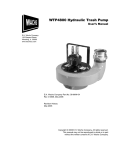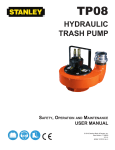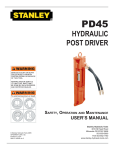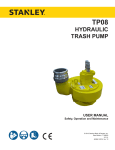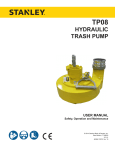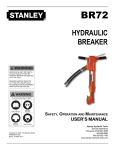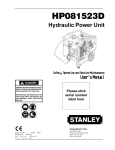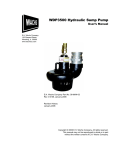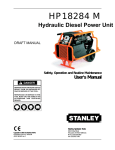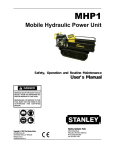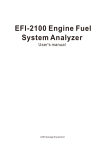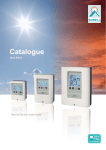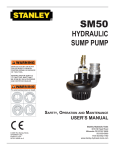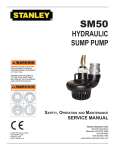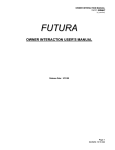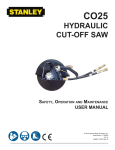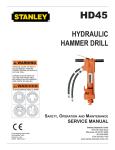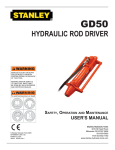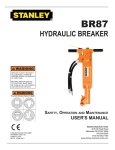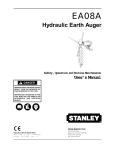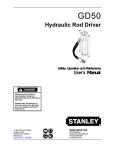Download TP08 Ops Manual 9
Transcript
TP08 HYDRAULIC TRASH PUMP WARNING SAFETY, OPERATION AND MAINTENANCE USER’S MANUAL © 2005 The Stanley Works SVCE/MAINT USA Printed in U.S.A. 66364 9/2005 ver 2 Stanley Hydraulic Tools 3810 SE Naef Road Milwaukie OR 97267-5698 503-659-5660 FAX 503-652-1780 www.stanley-hydraulic-tools.com TABLE OF CONTENTS SAFETY SYMBOLS......................................................................................................................................................................... 4 SAFETY PRECAUTIONS ................................................................................................................................................................ 5 TOOL STICKERS & TAGS .............................................................................................................................................................. 7 HYDRAULIC HOSE REQUIREMENTS ........................................................................................................................................... 8 HOSE TYPES .................................................................................................................................................................................. 8 HTMA REQUIREMENTS ................................................................................................................................................................. 9 OPERATION .................................................................................................................................................................................. 10 PREOPERATION PROCEDURES ........................................................................................................................................... 10 CHECK POWER SOURCE ...................................................................................................................................................... 10 CONNECT HOSES .................................................................................................................................................................. 10 PUMP OPERATION ................................................................................................................................................................. 10 COLD WEATHER OPERATION ............................................................................................................................................... 11 EQUIPMENT PROTECTION & CARE........................................................................................................................................... 12 TROUBLESHOOTING ................................................................................................................................................................... 13 SPECIFICATIONS ......................................................................................................................................................................... 14 ACCESSORIES ............................................................................................................................................................................. 14 TP08 PARTS ILLUSTRATION ....................................................................................................................................................... 15 TP08 PARTS LIST ......................................................................................................................................................................... 16 WARRANTY................................................................................................................................................................................... 17 SERVICING THE STANLEY HYDRAULIC Trash Pump. This manual contains safety, operation, and routine maintenance instructions. Stanley Hydraulic Tools recommends that servicing of hydraulic tools, other than routine maintenance, be performed by an authorized and certified dealer. Please read the following warning. WARNING SERIOUS INJURY OR DEATH COULD RESULT FROM THE IMPROPER REPAIR OR SERVICE OF THIS TOOL. REPAIRS AND / OR SERVICE TO THIS TOOL MUST ONLY BE DONE BY AN AUTHORIZED AND CERTIFIED DEALER. For the nearest authorized and certified dealer, call Stanley Hydraulic Tools at the number listed on the back of this manual and ask for a Customer Service Representative. 3 SAFETY SYMBOLS Safety symbols and signal words, as shown below, are used to emphasize all operator, maintenance and repair actions which, if not strictly followed, could result in a life-threatening situation, bodily injury or damage to equipment. This is the safety alert symbol. It is used to alert you to potential personal injury hazards. Obey all safety messages that follow this symbol to avoid possible injury or death. DANGER This safety alert and signal word indicate an imminently hazardous situation which, if not avoided, will result in death or serious injury. WARNING This safety alert and signal word indicate a potentially hazardous situation which, if not avoided, could result in death or serious injury. CAUTION This safety alert and signal word indicate a potentially hazardous situation which, if not avoided, may result in minor or moderate injury. This signal word indicates a potentially hazardous situation which, if not avoided, may result in property damage. NOTICE This signal word indicates a situation which, if not avoided, will result in damage to the equipment. IMPORTANT This signal word indicates a situation which, if not avoided, may result in damage to the equipment. Always observe safety symbols. They are included for your safety and for the protection of the tool. LOCAL SAFETY REGULATIONS Enter any local safety regulations here. Keep these instructions in an area accessible to the operator and maintenance personnel. 4 SAFETY PRECAUTIONS Tool operators and maintenance personnel must always comply with the safety precautions given in this manual and on the stickers and tags attached to the tool and hose. These safety precautions are given for your safety. Review them carefully before operating the tool and before performing general maintenance or repairs. Supervising personnel should develop additional precautions relating to the specific work area and local safety regulations. If so, place the added precautions in the space provided in this manual. The models TP08 Hydraulic Trash Pump will provide safe and dependable service if operated in accordance with the instructions given in this manual. Read and understand this manual and any stickers and tags attached to the tool and hoses before operation. Failure to do so could result in personal injury or equipment damage. • Operator must start in a work area without bystanders. The operator must be familiar with all prohibited work areas such as excessive slopes and dangerous terrain conditions. • Establish a training program for all operators to ensure safe operations. • Do not operate the tool unless thoroughly trained or under the supervision of an instructor. • Always wear safety equipment such as goggles, head protection, and safety shoes at all times when operating the tool. • Do not inspect or clean the tool while the hydraulic power source is connected. Accidental engagement of the tool can cause serious injury. • Do not operate this tool without first reading the Operating Instructions. • Do not install or remove this tool while the hydraulic power source is connected. Accidental engagement of the tool can cause serious injury. • Never operate the tool near energized transmission lines. know the location of buried or covered services before starting work. • Do not wear loose fitting clothing when operating the tool. Loose fitting clothing can get entangled with the tool and cause serious injury. • Supply hoses must have a minimum working pressure rating of 2500 psi/175 bar. • Be sure all hose connections are tight. • The hydraulic circuit control valve must be in the “OFF” position when coupling or uncoupling the tool. Wipe all couplers clean before connecting. Failure to do so may result in damage to the quick couplers and cause overheating. Use only lint-free cloths. • Do not operate the tool at oil temperatures above 140° F/60° C. Operation at higher oil temperatures can cause operator discomfort and may cause damage to the tool. • Do not operate a damaged, improperly adjusted, or incompletely assembled tool. 5 SAFETY PRECAUTIONS • To avoid personal injury or equipment damage, all tool repair, maintenance and service must only be performed by authorized and properly trained personnel. • Do not exceed the rated limits of the tool or use the tool for applications beyond its design capacity. • Always keep critical tool markings, such as labels and warning stickers legible. • Always replace parts with replacement parts recommended by Stanley Hydraulic Tools. • Check fastener tightness often and before each use daily. • Do not put your hands or any other body part under the volute while the trash pump is running. • Do not lift the trash pump by pulling on the hydraulic hoses. Use a suitable line fastened to the trash pump handle. • Do not point water discharge toward bystanders. 6 TOOL STICKERS & TAGS Stanley Hydraulic tools Division of the Stanley Works 3810 SE Naef Road Milwaukie, OR 97267 05152 Stanley Logo Decal Stanley Hydraulic Tools 3810 SE Naef Road Milwaukie, OR 97267 MODEL NO. TP08 7-10 GPM / 26-38 LPM 2000 PSI/ 140 B AR 22360 Name Tag 03787 GPM Decal D A N G E R D A N G E R 1. FAILURE TO USE HYDRAULIC HOSE LABELED AND CERTIFIED AS NON-CONDUCTIVE WHEN USING HYDRAULIC TOOLS ON OR NEAR ELECTRICAL LINES MAY RESULT IN DEATH OR SERIOUS INJURY. BEFORE USING HOSE LABELED AND CERTIFIED AS NON-CONDUCTIVE ON OR NEAR ELECTRIC LINES BE SURE THE HOSE IS MAINTAINED AS NON-CONDUCTIVE. THE HOSE SHOULD BE REGULARLY TESTED FOR ELECTRIC CURRENT LEAKAGE IN ACCORDANCE WITH YOUR SAFETY DEPARTMENT INSTRUCTIONS. 2. A HYDRAULIC LEAK OR BURST MAY CAUSE OIL INJECTION INTO THE BODY OR CAUSE OTHER SEVERE PERSONAL INJURY. A DO NOT EXCEED SPECIFIED FLOW AND PRESSURE FOR The safety tag (p/n 15875) at right is attached to the tool when shipped from the factory. Read and understand the safety instructions listed on this tag before removal. We suggest you retain this tag and attach it to the tool when not in use. 3. MAKE SURE HYDRAULIC HOSES ARE PROPERLY CONNECTED TO THE TOOL BEFORE PRESSURING SYSTEM. SYSTEM PRESSURE HOSE MUST ALWAYS BE CONNECTED TO TOOL “IN” PORT. SYSTEM RETURN HOSE MUST ALWAYS BE CONNECTED TO TOOL “OUT” PORT. REVERSING CONNECTIONS MAY CAUSE REVERSE TOOL OPERATION WHICH CAN RESULT IN SEVERE PERSONAL INJURY. 4. DO NOT CONNECT OPEN-CENTER TOOLS TO CLOSED-CENTER HYDRAULIC SYSTEMS. THIS MAY RESULT IN LOSS OF OTHER HYDRAULIC FUNCTIONS POWERED BY THE SAME SYSTEM AND/OR SEVERE PERSONAL INJURY. 5. BYSTANDERS MAY BE INJURED IN YOUR WORK AREA. KEEP BYSTANDERS CLEAR OF YOUR WORK AREA. IMPORTANT IMPORTANT READ OPERATION MANUAL AND SAFETY INSTRUCTIONS FOR THIS TOOL BEFORE USING IT. READ OPERATION MANUAL AND SAFETY INSTRUCTIONS FOR THIS TOOL BEFORE USING IT. USE ONLY PARTS AND REPAIR PROCEDURES APPROVED BY STANLEY AND DESCRIBED IN THE OPERATION MANUAL. USE ONLY PARTS AND REPAIR PROCEDURES APPROVED BY STANLEY AND DESCRIBED IN THE OPERATION MANUAL. TAG TO BE REMOVED ONLY BY TOOL OPERATOR. TAG TO BE REMOVED ONLY BY TOOL OPERATOR. SAFETY TAG P/N 15875 7 D DO NOT LIFT OR CARRY TOOL BY THE HOSES. DO NOT ABUSE HOSE. DO NOT USE KINKED, TORN OR DAMAGED HOSE. (shown smaller then actual size) HYDRAULIC HOSE REQUIREMENTS HOSE TYPES Hydraulic hose types authorized for use with Stanley Hydraulic Tools are as follows: Certified non-conductive Wire-braided (conductive) Fabric-braided (not certified or labeled non-conductive) Hose listed above is the only hose authorized for use near electrical conductors. Hoses and listed above are conductive and must never be used near electrical conductors. HOSE SAFETY TAGS To help ensure your safety, the following DANGER tags are attached to all hose purchased from Stanley Hydraulic Tools. DO NOT REMOVE THESE TAGS. If the information on a tag is illegible because of wear or damage, replace the tag immediately. A new tag may be obtained from your Stanley Distributor. D A N G E R D A N G E R 1 FAILURE TO USE HYDRAULIC HOSE LABELED AND CERTIFIED AS NON-CONDUCTIVE WHEN USING HYDRAULIC TOOLS ON OR NEAR ELECTRIC LINES MAYRESULT IN DEATH OR SERIOUS INJURY. FOR PROPER AND SAFE OPERATION MAKE SURE THAT YOU HAVE BEEN PROPERLY TRAINED IN CORRECT PROCEDURES REQUIRED FOR WORK ON OR AROUND ELECTRIC LINES. 3. DO NOT EXCEED HOSE WORKING PRESSURE OR ABUSE HOSE. IMPROPER USE OR HANDLING OF HOSE COULD RESULT IN BURST OR OTHER HOSE FAILURE. KEEP HOSE AS FAR AWAY AS POSSIBLE FROM BODY AND DO NOT PERMIT DIRECT CONTACT DURING USE. CONTACT AT THE BURST CAN CAUSE BODILY INJECTION AND SEVERE PERSONAL INJURY. 4. HANDLE AND ROUTE HOSE CAREFULLY TO AVOID KINKING, ABRASION, CUTTING, OR CONTACT WITH HIGH TEMPERATURE SURFACES. DO NOT USE IF KINKED. DO NOT USE HOSE TO PULL OR LIFT TOOLS, POWER UNITS, ETC. 2. BEFORE USING HYDRAULIC HOSE LABELED AND CERTIFIED AS NON-CONDUCTIVE ON OR NEAR ELECTRIC LINES. WIPE THE ENTIRE LENGTH OF THE HOSE AND FITTING WITH A CLEAN DRY ABSORBENT CLOTH TO REMOVE DIRT AND MOSISTURE AND TEST HOSE FOR MAXIMUM ALLOWABLE CURRENT LEAKAGE IN ACCORDANCE WITH SAFETY DEPARTMENT INSTRUCTIONS. 5. CHECK ENTIRE HOSE FOR CUTS CRACKS LEAKS ABRASIONS, BULGES, OR DAMAGE TO COUPLINGS IF ANY OF THESE CONDITIONS EXIST, REPLACE THE HOSE IMMEDIATELY. NEVER USE TAPE OR ANY DEVICE TO ATTEMPT TO MEND THE HOSE. 6. AFTER EACH USE STORE IN A CLEAN DRY AREA. SIDE 1 3 DO NOT REMOVE THIS TAG DO NOT REMOVE THIS TAG THE TAG SHOWN BELOW IS ATTACHED TO “CERTIFIED NON-CONDUCTIVE” HOSE SIDE 2 (shown smaller than actual size) D A N G E R D A N G E R 1 DO NOT USE THIS HYDRAULIC HOSE ON OR NEAR ELECTRIC LINES. THIS HOSE IS NOT LABELED OR CERTIFIED AS NON-CONDUCTIVE. USING THIS HOSE ON OR NEAR ELECTRICAL LINES MAY RESULT IN DEATH OR SERIOUS INJURY. 5. CHECK ENTIRE HOSE FOR CUTS CRACKS LEAKS ABRASIONS, BULGES, OR DAMAGE TO COUPLINGS IF ANY OF THESE CONDITIONS EXIST, REPLACE THE HOSE IMMEDIATELY. NEVER USE TAPE OR ANY DEVICE TO ATTEMPT TO MEND THE HOSE. 2. FOR PROPER AND SAFE OPERATION MAKE SURE THAT YOU HAVE BEEN PROPERLY TRAINED IN CORRECT PROCEDURES REQUIRED FOR WORK ON OR AROUND ELECTRIC LINES. 6. AFTER EACH USE STORE IN A CLEAN DRY AREA. 3. DO NOT EXCEED HOSE WORKING PRESSURE OR ABUSE HOSE. IMPROPER USE OR HANDLING OF HOSE COULD RESULT IN BURST OR OTHER HOSE FAILURE. KEEP HOSE AS FAR AWAY AS POSSIBLE FROM BODY AND DO NOT PERMIT DIRECT CONTACT DURING USE. CONTACT AT THE BURST CAN CAUSE BODILY INJECTION AND SEVERE PERSONAL INJURY. 4. HANDLE AND ROUTE HOSE CAREFULLY TO AVOID KINKING, CUTTING, OR CONTACT WITH HIGH TEMPERATURE SURFACES. DO NOT USE IF KINKED. DO NOT USE HOSE TO PULL OR LIFT TOOLS, POWER UNITS, ETC. DO NOT REMOVE THIS TAG DO NOT REMOVE THIS TAG THE TAG SHOWN BELOW IS ATTACHED TO “CONDUCTIVE” HOSE. SEE OTHER SIDE SIDE 1 SIDE 2 (shown smaller than actual size) HOSE PRESSURE RATING The rated working pressure of the hydraulic hose must be equal to or higher than the relief valve setting on the hydraulic system. 8 HTMA REQUIREMENTS TOOL CATEGORY HYDRAULIC SYSTEM REQUIREMENTS FLOW RATE TYPE 1 TYPE II 7-9 gpm (26-34 lpm) 2000 psi (138 bar) TYPE III TOOL OPERATING PRESSURE (at the power supply outlet) 4-6 gpm (15-23 lpm) 2000 psi (138 bar) SYSTEM RELIEF VALVE SETTING (at the power supply outlet) 2100-2250 psi 2100-2250 psi 2100-2250 psi 2200-2300 psi (145-155 bar) (145-155 bar) (145-155 bar) (152-159 bar) MAXIMUM BACK PRESSURE (at tool end of the return hose) 250 psi (17 bar) Measured at a max. fluid viscosity of: (at min. operating temperature) 400 ssu* 400 ssu* 400 ssu* 400 ssu* (82 centistokes) (82 centistokes) (82 centistokes) (82 centistokes) TEMPERATURE Sufficient heat rejection capacity to limit max. fluid temperature to: (at max. expected ambient temperature) 140° F (60° C) 140° F (60° C) 140° F (60° C) 140° F (60° C) Min. cooling capacity at a temperature difference of between ambient and fluid temps 3 hp (2.24 kW) 40° F (22° C) 5 hp (3.73 kW) 40° F (22° C) 7 hp (4.47 kW) 40° F (22° C) 6 hp (5.22 kW) 40° F (22° C) 250 psi (17 bar) 11-13 gpm (42-49 lpm) 2000 psi (138 bar) TYPE RR 250 psi (17 bar) 9-10.5 gpm (34-40 lpm) 2000 psi (138 bar) 250 psi (17 bar) NOTE: Do not operate the tool at oil temperatures above 140° F (60° C). Operation at higher temperatures can cause operator discomfort at the tool. FILTER 25 microns Min. full-flow filtration 30 gpm Sized for flow of at least: (114 lpm) (For cold temp. startup and max. dirt-holding capacity) 25 microns 30 gpm (114 lpm) HYDRAULIC FLUID Petroleum based (premium grade, anti-wear, non-conductive) VISCOSITY (at min. and max. operating temps) 100-400 ssu* 100-400 ssu* (20-82 centistokes) 100-400 ssu* 25 microns 30 gpm (114 lpm) 25 microns 30 gpm (114 lpm) 100-400 ssu* NOTE: When choosing hydraulic fluid, the expected oil temperature extremes that will be experienced in service determine the most suitable temperature viscosity characteristics. Hydraulic fluids with a viscosity index over 140 will meet the requirements over a wide range of operating temperatures. *SSU = Saybolt Seconds Universal NOTE: These are general hydraulic system requirements. See tool Specification page for tool specific requirements. 9 OPERATION PREOPERATION PROCEDURES PUMP OPERATION CHECK POWER SOURCE 1. Observe all safety precautions. 1. Using a calibrated flow meter and pressure gauge, make sure the hydraulic power source develops a flow of 7-10 gpm/26-38 Ipm at 2000 psi/140 bar. 2. Attach a 4-inch/102 mm diameter fire hose to the trash pump outlet. .For best performance, keep the fire hose as short as possible and lay it out to avoid sharp bends or kinks. 2. Make certain that the power source is equipped with a relief valve set to open at 2100-2250 psi/145-155 bar maximum. Do not attach a nozzle to the outlet end of the fire hose. For high-pressure water pumping, use a Stanley SM20 or SM50 and nozzle. The TP08 is designed for high GPM water flow at low water pressure (head). 3. Make certain that the power source return pressure does not exceed 250 psi/17 bar. 3. Attach a rope or cable to the trash pump’s handle. Lower the trash pump into the liquid to be pumped. Do not raise or lower the trash pump by its hoses or couplers to avoid damage to the hoses or couplers. 4. Make sure the trash pump inlet is clear of debris. Remove any obstruction before operating. CONNECT HOSES IMPORTANT 1. Wipe all hose couplers with a clean lint free cloth before making connections. Never point the hose at bystanders. IMPORTANT 4. Turn on the hydraulic power source. Watch for solids in the liquid being pumped. If solids are excessive, the discharge flow might decrease. If this happens, stop the trash pump and check for the cause of the problem. Do not connect pressure to the return port. Motor shaft seal limit Is 250 psl/17 bar. Under some conditions, the liquid being pumped might be slowed enough so It can no longer push particles in the liquid. If this happens, particles can accumulate in the pumping chamber, causing further restriction. The impeller then acts as a “grinding wheel: which causes accelerated trash pump wear. Reduced liquid flow can be caused by the following: 2. Connect the hoses from the hydraulic power source to the couplers on the trash pump or trash pump hoses. It is a good practice to connect return hose first and disconnect it last to minimize or avoid trapped pressure within the trash pump motor. Note: If uncoupled hoses are left in the sun, pressure increase inside the hoses might make them difficult to connect. Whenever possible, connect the free ends of the hoses together. • The trash pump sinks into solids at the bottom of the hole. • The end of the outlet hose is too high, causing an excessive lift height for the column of liquid being pushed by the trash pump. This slows the flow of liquid to a level where it can no longer carry solids. 3. Observe the arrow on the couplers to ensure that the flow is in the proper direction. The female coupler on the trash pump is the inlet (pressure) coupler. • The flow and pressure of hydraulic fluid to the trash pump is too low, which reduces impeller speed. A 20 percent decrease in hydraulic fluid flow can reduce pump performance by 50 percent. When operating at reduced hydraulic flow and pressure, the end of the outlet hose should not be more than 30 ft/9 m above the liquid. Note: It will not damage the pump to operate it “dry.” 10 OPERATION 5. When pumping is complete, set the hydraulic control valve to the “OFF” position. Lift the trash pump from the work area using the rope or cable to avoid damage to the hoses or couplers. IMPORTANT Observe the following for trash pump protection and care. 6. The trash pump must maintain a minimum impeller speed in order to move solid particles through the pump. While pumping liquids containing large solids, monitor the flow from the outlet of the fire hose. If it begins to slow, turn off the hydraulic power source and lift the trash pump from the work area. Disconnect the hydraulic hoses and clean at the water hose and the pumping chamber. IMPORTANT Pumping liquids with a solids-to liquid ratio greater than 30 percent solids to 70 percent liquid will cause accelerated impeller wear. 7. To maintain optimum performance, it is good practice to periodically inspect the impeller for wear or damage. This is especially important following the pumping of liquids containing sharp, abrasive solids. COLD WEATHER OPERATION If the trash pump is to be used during cold weather, preheat the hydraulic fluid at low power source speed. When using the normally recommended fluids, fluid should be at or above 50°F/10° C (400 ssu/82 centistokes) before use. Damage to the hydraulic system or pump motor seals can result from use with fluid that is too viscous or thick. 11 EQUIPMENT PROTECTION & CARE NOTICE In addition to the Safety Precautions in this manual, observe the following for equipment protection and care. • Make sure all couplers are wiped clean before connection. • The hydraulic circuit control valve must be in the “OFF” position when coupling or uncoupling hydraulic tools. Failure to do so may result in damage to the quick couplers and cause overheating of the hydraulic system. • Always store the tool in a clean dry space, safe from damage or pilferage. • Make sure the circuit PRESSURE hose (with male quick disconnect) is connected to the “IN” port. The circuit RETURN hose (with female quick disconnect) is connected to the opposite port. Do not reverse circuit flow. This can cause damage to internal seals. • Always replace hoses, couplings and other parts with replacement parts recommended by Stanley Hydraulic Tools. Supply hoses must have a minimum working pressure rating of 2500 psi/172 bar. • Do not exceed the rated flow or pressure (refer to Specifications in this manual for correct flow rate and pressure). If specifications are exceeded, rapid failure of the internal seals may result. • Always keep critical tool markings, such as warning stickers and tags legible. • Tool repair should be performed by experienced personnel only. • Make certain that the recommended relief valves are installed in the pressure side of the system. • Do not use the tool for applications for which it was not intended. 12 TROUBLESHOOTING If symptoms of poor performance develop, the following chart can be used as a guide to correct the problem. When diagnosing faults in operation of the tool, always make sure the hydraulic power source is supplying the correct hydraulic flow and pressure as listed in the table. Use a flowmeter know to be accurate. check the flow with the hydraulic fluid temperature at least 80o F/27o C. PROBLEM Pump will not start. Poor pump performance. CAUSE SOLUTION No hydraulic fluid flow or pressure. Turn on power unit and check that 7-10 gpm/26-38 lpm at 2000 psi/140 bar is available at the trash pump. Defective couplers. Check the couplers by connecting them together with the hydraulic power supply operating and with the control valve in the “ON” position. The power supply should operate without “loading” from the couplers. Impeller jammed with debris. Clean the pumping chamber. Impeller rubbing against wear plates. Check and adjust the impeller clearance. Defective power module. Repair or replace the power module. Hydraulic flow reversed. Check that the hoses are correctly connected to the pump motor ports. The female coupler should be connected to the “IN” port. The return fluid must never flow through a reversing valve. Improper hydraulic fluid flow. Check that 7-10 gpm/26-38 lpm at 2000 psi/140 bar is available at the trash pump. A 20% decrease in flow can result in a 50% decrease in pump performance. 8 gpm/30 lpm is the best circuit flow. Trash pump submersed in sediment. Lift the pump from the bottom of the hole or chamber. Use a flat support under the pump if necessary. Trash pump inlet restricted. Remove restriction and thoroughly clean. Discharge hose kinked or restricted. Straighten the hoes. If the hose must bend at the top of the hole, use a piece of split rigid conduit with large diameter of the expanded hose. This keeps the hose from kinking. Use a 90° 4-inch pipe elbow on the trash pump outlet if necessary. Discharge hose too small. Use a 4-inch diameter fire hose. Water lift too high. Lower the outlet end of the discharge hose. Impeller worn or damaged. Check impeller for damage and excessive wear. Replace if necessary. Wear plates worn or damaged. Check wear plates for damage and excessive wear. Replace if necessary. Replace the motor shaft seal. Hydraulic fluid in discharge flow. Motor shaft seal failure. 13 Ensure power unit is delivering 7-10 gpm/26-38 lpm SPECIFICATIONS Capacity ................................................................................................................................................... 800 gpm/3028 lpm Weight ............................................................................................................................................................. 59 lbs/26.7 kg Height (over handle) ........................................................................................................................................ 16.5 in./42 cm Length ............................................................................................................................................................. 19 in./48.3 cm Width ............................................................................................................................................................... 15 in./38.1 cm Pressure ...................................................................................................................................................... 2000 psi/140 bar Flow Range ........................................................................................................................................... 7-10 gpm/26-38 lpm Maximum Flow ............................................................................................................................................... 10 gpm/38 lpm Porting ........................................................................................................................ #10 SAE (pressure) #12 SAE (return) Connect Size and Type .....................................................................1/2 in. Male Pipe (pressure) 1/2 in. Male Pipe (return) Discharge Diameter ............................................................................................................................4 in./100 mm Camlock Inlet Diameter .................................................................................................................................................... 4 in./100 mm ACCESSORIES Description Part No. Adapter, 3 in. NPT/3 in. Camlock Male ........................................................................................................................52720 Lay-Flat Discharge Hose, 3 in. x 25 ft with Camlock Fittings .......................................................................................56761 Lay-Flat Discharge Hose, 4 in. x 25 ft with Camlock Fittings .......................................................................................65624 14 TP08 PARTS ILLUSTRATION 3 19 14 54 48 15 TP08 PARTS LIST Item No. Part No. Qty Description Item No. Part No. Qty Description 1 31505 1 Motor Assy (Incl 20, 24, 29-48) 33 21021 1 Seal 2 21960 1 Volute Weldment 34 ----- -- NO ITEM 3 21961 6 Wing Nut 35 01872 1 O-Ring 4 65783 6 Capscrew 36 26812 1 Retaining Ring 5 12 6 6 3 Lockwasher Capscrew (TP08013 Only) Capscrew (TP0801302 Only) Capscrew 37 20680 2 Bearing Race 38 08020 1 Thrust Bearing 7 01324 08937 15476 15476 39 21971 1 Motor Shaft 8 00788 3 Hex Nut 40 21985 1 Key 9 21963 3 Brace 41 20691 1 Bearing Carrier 10 21964 1 Wear Plate 42 22065 2 Dowel Pin 11 21965 1 Base 43 21974 1 Drive Gear 12 21966 A/R Shim 44 21983 1 Idler Gear 13 21967 1 Male Camlock 45 21984 1 Idler Shaft 14 21968 1 Handle 46 15385 1 O-Ring 15 05152 1 Decal, Stanley 47 21972 1 Motor Cap Assy 16 03787 1 Sticker, GPM 48 21986 3 Capscrew 17 22360 1 Sticker, Name Tag 49 10793 2 Capscrew 18 15875 1 Warning Tag (Not Shown) 50 06264 1 Adapter 19 15664 8 Washer 51 06891 1 O-Ring (Supplied with Item 50) 20 21978 3 Capscrew 52 07882 1 Adapter 21 21977 1 Plate - Volute/Motor Mount 53 01604 1 O-Ring (Supplied with Item 52) 22 21993 1 Wear Plate Top 54 21987 2 Capscrew 23 21979 1 Impeller 24 06311 1 V-Ring 22546 1 SEAL KIT 25 21988 1 Acorn Nut 26 03827 1 Washer 27 00600 1 Woodruff Key 28 21989 6 Capscrew 29 21981 1 Seal Anvil 30 21976 1 Housing Lip Excluder 31 01220 1 Grease Fitting 32 31266 1 Seal Carrier 6 16 WARRANTY Stanley Hydraulic Tools (hereinafter called “Stanley”), subject to the exceptions contained below, warrants new hydraulic tools for a period of one year from the date of sale to the first retail purchaser, or for a period of 2 years from the shipping date from Stanley, whichever period expires first, to be free of defects in material and/or workmanship at the time of delivery, and will, at its option, repair or replace any tool or part of a tool, or new part, which is found upon examination by a Stanley authorized service outlet or by Stanley’s factory in Milwaukie, Oregon to be DEFECTIVE IN MATERIAL AND/OR WORKMANSHIP. EXCEPTIONS FROM WARRANTY NEW PARTS: New parts which are obtained individually are warranted, subject to the exceptions herein, to be free of defects in material and/or workmanship at the time of delivery and for a period of 6 months after the date of first usage. Seals and diaphragms are warranted to be free of defects in material and/or workmanship at the time of delivery and for a period of 6 months after the date of first usage or 2 years after the date of delivery, whichever period expires first. Warranty for new parts is limited to replacement of defective parts only. Labor is not covered. FREIGHT COSTS: Freight costs to return parts to Stanley, if requested by Stanley for the purpose of evaluating a warranty claim for warranty credit, are covered under this policy if the claimed part or parts are approved for warranty credit. Freight costs for any part or parts which are not approved for warranty credit will be the responsibility of the individual. SEALS & DIAPHRAGMS: Seals and diaphragms installed in new tools are warranted to be free of defects in material and/or workmanship for a period of 6 months after the date of first usage, or for a period of 2 years from the shipping date from Stanley, whichever period expires first. CUTTING ACCESSORIES: Cutting accessories such as breaker tool bits are warranted to be free of defects in material and or workmanship at the time of delivery only. ITEMS PRODUCED BY OTHER MANUFACTURERS: Components which are not manufactured by Stanley and are warranted by their respective manufacturers. a. Costs incurred to remove a Stanley manufactured component in order to service an item manufactured by other manufacturers. ALTERATIONS & MODIFICATIONS: Alterations or modifications to any tool or part. All obligations under this warranty shall be terminated if the new tool or part is altered or modified in any way. NORMAL WEAR: any failure or performance deficiency attributable to normal wear and tear such as tool bushings, retaining pins, wear plates, bumpers, retaining rings and plugs, rubber bushings, recoil springs, etc. INCIDENTAL/CONSEQUENTIAL DAMAGES: To the fullest extent permitted by applicable law, in no event will STANLEY be liable for any incidental, consequential or special damages and/or expenses. FREIGHT DAMAGE: Damage caused by improper storage or freight handling. LOSS TIME: Loss of operating time to the user while the tool(s) is out of service. IMPROPER OPERATION: Any failure or performance deficiency attributable to a failure to follow the guidelines and/or procedures as outlined in the tool’s operation and maintenance manual. MAINTENANCE: Any failure or performance deficiency attributable to not maintaining the tool(s) in good operating condition as outlined in the Operation and Maintenance Manual. HYDRAULIC PRESSURE & FLOW, HEAT, TYPE OF FLUID: Any failure or performance deficiency attributable to excess hydraulic pressure, excess hydraulic back-pressure, excess hydraulic flow, excessive heat, or incorrect hydraulic fluid. REPAIRS OR ALTERATIONS: Any failure or performance deficiency attributable to repairs by anyone which in Stanley’s sole judgement caused or contributed to the failure or deficiency. MIS-APPLICATION: Any failure or performance deficiency attributable to mis-application. “Mis-application” is defined as usage of products for which they were not originally intended or usage of products in such a matter which exposes them to abuse or accident, without first obtaining the written consent of Stanley. PERMISSION TO APPLY ANY PRODUCT FOR WHICH IT WAS NOT ORIGINALLY INTENDED CAN ONLY BE OBTAINED FROM STANLEY ENGINEERING. WARRANTY REGISTRATION: STANLEY ASSUMES NO LIABILITY FOR WARRANTY CLAIMS SUBMITTED FOR WHICH NO TOOL REGISTRATION IS ON RECORD. In the event a warranty claim is submitted and no tool registration is on record, no warranty credit will be issued without first receiving documentation which proves the sale of the tool or the tools’ first date of usage. The term “DOCUMENTATION” as used in this paragraph is defined as a bill of sale, or letter of intent from the first retail customer. A WARRANTY REGISTRATION FORM THAT IS NOT ALSO ON RECORD WITH STANLEY WILL NOT BE ACCEPTED AS “DOCUMENTATION”. NO ADDITIONAL WARRANTIES OR REPRESENTATIONS This limited warranty and the obligation of Stanley thereunder is in lieu of all other warranties, expressed or implied including merchantability or fitness for a particular purpose except for that provided herein. There is no other warranty. This warranty gives the purchaser specific legal rights and other rights may be available which might vary depending upon applicable law. 17 Stanley Hydraulic Tools 3810 SE Naef Road Milwaukie, Oregon 503-659-5660 / Fax 503-652-1780 www.stanley-hydraulic-tools.com


















